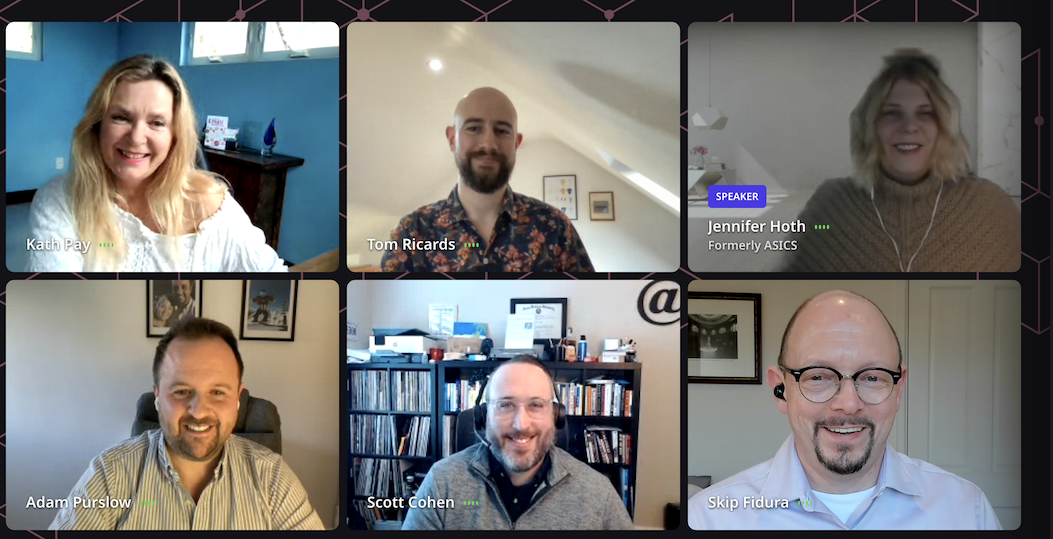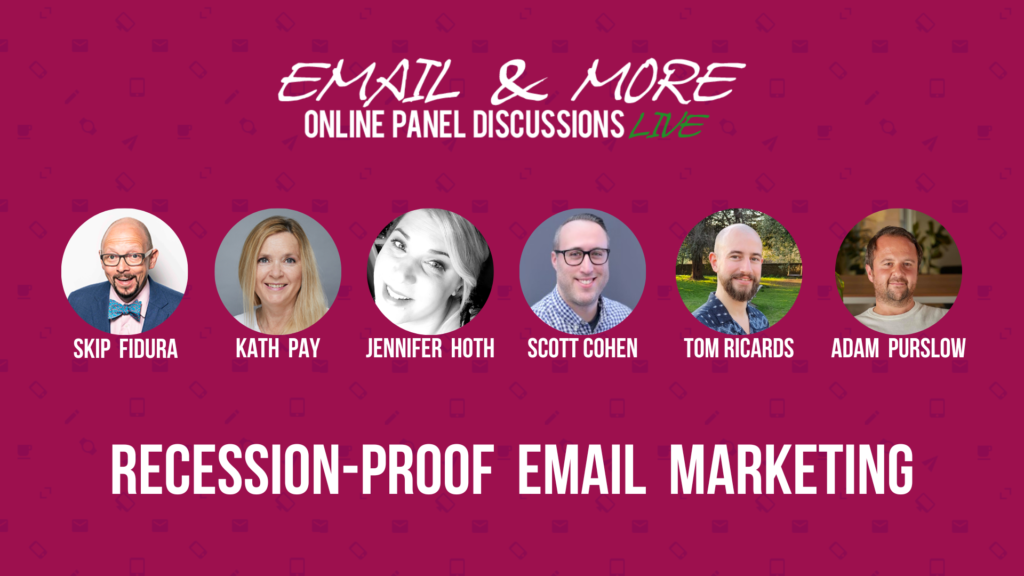Recession-proof Email Marketing – An Email & More Recap
A tough topic: Recession-proof email marketing. What goes up must come down, and in the business world that coming down can be very hard and sudden indeed. A recession has arrived, customers are spending less, and a company must look to tighten its belt. Three areas tend to stand out for cost-saving: rent and physical facilities, salaries and marketing. The first tends to be built on multiyear arrangements and isn’t something easily cut back on quickly. Meanwhile reducing headcount to lower the salary bill can be seriously damaging to an organisation’s morale and expensive in redundancy fees.
So that leaves Marketing. If you’re reading this, that probably means you. An email marketer heading into a recession and expected to achieve more with less. So how do you cope and recession-proof your email marketing? That was the topic opening the 2023 season of Email and More, Holistic Email Marketings series of free industry webinars exploring all things email marketing.
As with our previous three seasons, we assembled an expert panel of email marketing gurus to give us their insights. Joining Holistic CEO and Founder Kathy Pay and Moderator and Fractional CMO Skip Fidura were:
- Scott Cohen – SmileDirectClub
- Jennifer Hoth – formerly of ASICS
- Tom Richards of Bloomreach
- Adam Purslow – TheLoyaltyCo
Recession-Proofing Emails – According to the Experts.
We didn’t know it at the time, but the Covid years were just preparation for what was to come. While for some businesses, the pandemic represented a boom time many other organisations found themselves effectively closed down. Even when Governments graciously permitted stores to open for a few hours, customers simply did not come as frequently as they once did.
Covid is now, thankfully a thing of the past (we say with crossed fingers). But the lessons learned in those times carried over into present recessions. While we would agree that a lack of money is probably better than a killer virus, it’s still a somewhat problematic situation for businesses and the email marketers who work for them.
In such times as these where customer demand is flagging, Adam recommended that the key was to ensure you kept talking to your customers. “The key is for businesses to push on with engagement” he advised. “If people are going out one or two times per month, or even once a year, being that one venue that they go to is so important.”
This could be achieved by a strategy of gently nudging the customer. Using emails and other channels such as SMS you can remain at the edge of the customer’s thoughts. That way when they’re finally ready to take action and spend money they know you’re there waiting for them.
A Return on Investment – Email as the Cost-Effective Option
Another major factor in protecting yourself in a recession is the well-known fact that the ROI, or Return on Investment, on email as a channel is tremendous. “If you need to convince higher powers, there’s your reason” explains Tom when he described how in the 13 years since he began, the ROI on email has gone from £20 gained from each £1 spent to over £43 for every pound spent on email.”
However, the fact that email is known to be so cost-effective can be a two-edged sword. As recessions take shape and acquisitions of new customers become more expensive, office bosses around the world love to suggest more emails. Scott describes this as now being under a microscope because, in the manager mindset, “Email is the channel we can use because it costs fractions of a penny to send”. So, thinks the boss, why not send double, or triple?
As any good email marketer knows, this is a great way to end up caught by the great wall of spam filters and get your company put in email jail. That is why the trick is not to spam contacts relentlessly but to intelligently target them based on the data you already hold about them. Segmentation and targeting becomes a key strategy. Identifying the different groups of customers and what they are most likely to respond to. Entertaining newsletters, helpful advice, even money off vouchers – whatever it takes.
Better Data – Better Results
As email marketers, you can never have too much data, or more specifically insights into your customers and what they want. During quieter times Jennifer advised taking the opportunity to gather more zero- and first-party data on your customers. If you can understand their mindset, who they are and why they are making a purchase you can use that information to market and win over others.
“It’s not enough to just look at the transactional data” Jennifer said. “You want to get to know these people on a more personal basis”. Doing so can provide a valuable insight into what your customer base really thinks and how best you can serve their needs.
For example, Jennifer discussed a campaign she had been involved in for a shoe company that made shoes for marathon runners. Rather than a sales campaign, these messages invited customers to have their say on the products the company manufactured. The results revealed, interestingly, that almost a third of the respondents didn’t run and didn’t care about marathon running at all. An entirely new customer segment was revealed that could, with the right enticements, be grown.
And that’s great because at the end of the day, a sale is a sale. So long as the customer got what they wanted, we got what we wanted. Everyone wins!
Best Practice in the Worst of Times
Taking questions from the audience in recession-hit times, audience member Heather asked the panel:
“Are some of the things we regard as best practice in need of tweaking because we’re in difficult economic times?”
Naturally, no-one wants to abandon hard-won best practices, but sometimes, the panel agreed, the rules need to be bent a little. Where it was common to send a re-engagement email to a customer after say a month of no activity, and perhaps a coupon after three the panel unanimously agreed that it was a good idea to extend these time frames. “I would definitely give your customers some grace” Jennifer put it discussing purchase cycles and automations.
Kath meanwhile explained how recessions and their accompanying job losses forced a rethink in Holistic’s own data-gathering activities. Previously, signing up to Holistic email marketing required the giving of the requester’s business address – a hard thing to do when you’re a recent casualty of the job market. This was changed since, just because an email marketer was out of work, they didn’t want to be out of touch with the hottest tips and insight in email marketing (in our most humble opinion!). “Think about your recipients and make it as easy as possible for them to connect with you” Kath summarised.
Thinking about the bottom line, Tom gave some advice about the wisdom, or lack thereof, of coupons. Investigating the analytics for one client, Tom realised that the regular 10% off coupons they were giving away did not seem to have any effect on engagement. The customers that bought would still buy without the coupon meaning that the company was losing money it didn’t need to – a painful loss in a tough economic situation!
Finally, Scott and Jen advocated for reaching out within your organisation and making friends. “Become best friends with your web team. Become best friends with your analytics team” Scott advocated. “Think about customer performance and less about email importance”. As much as we may hate to admit it, there are other channels than email and it’s important to work with other parts of the business, especially during rough times.
After all, as Jennifer put it: “Everybody should just be happy because you’re getting a sale!”.
Check out all 4 previous seasons available on demand for your convenience. Sign up for our Insights Newsletter to make sure you don’t miss future panels as Season 5 kicks off with Email Marketing Calls-to-Actions That Convert on 26 March 2024.




